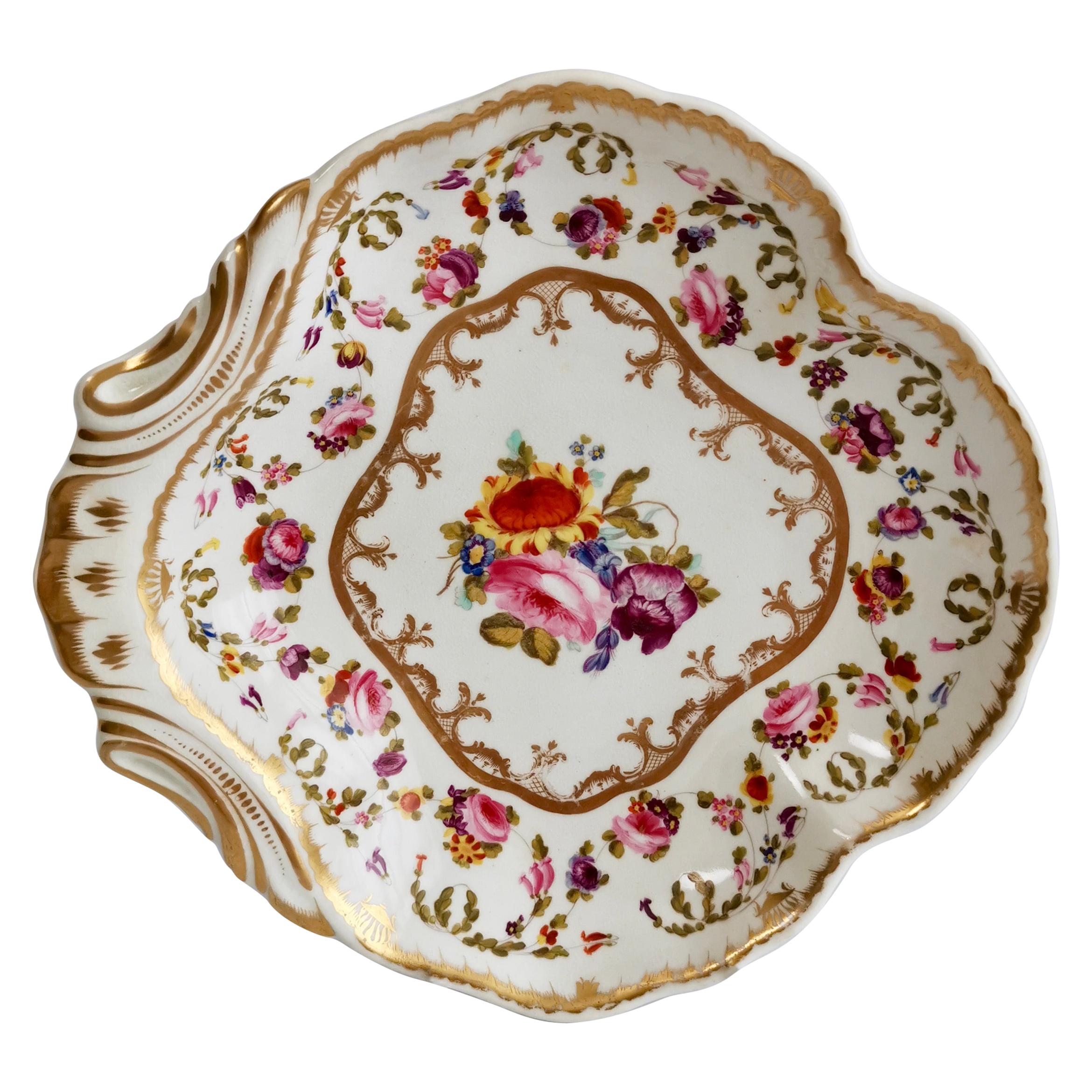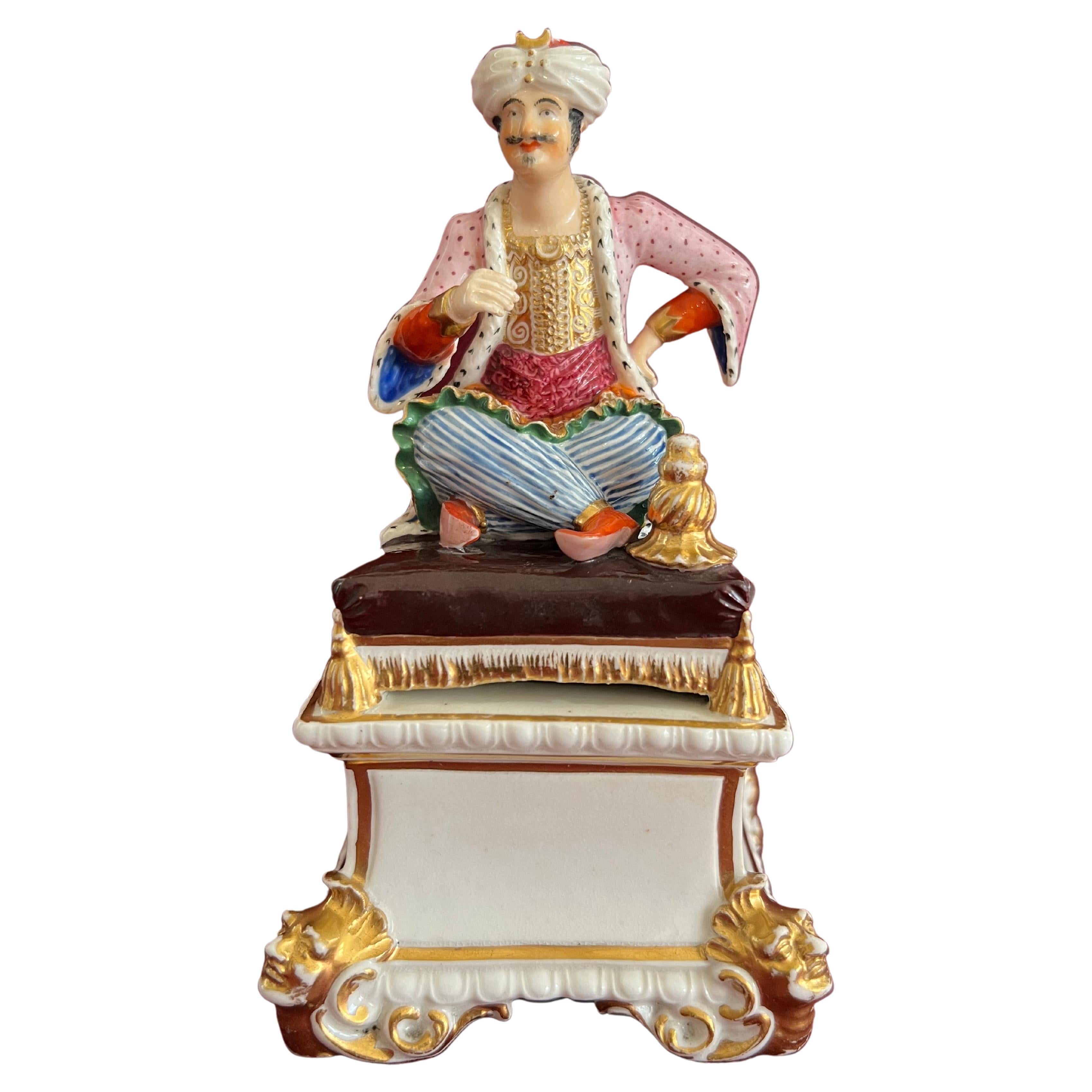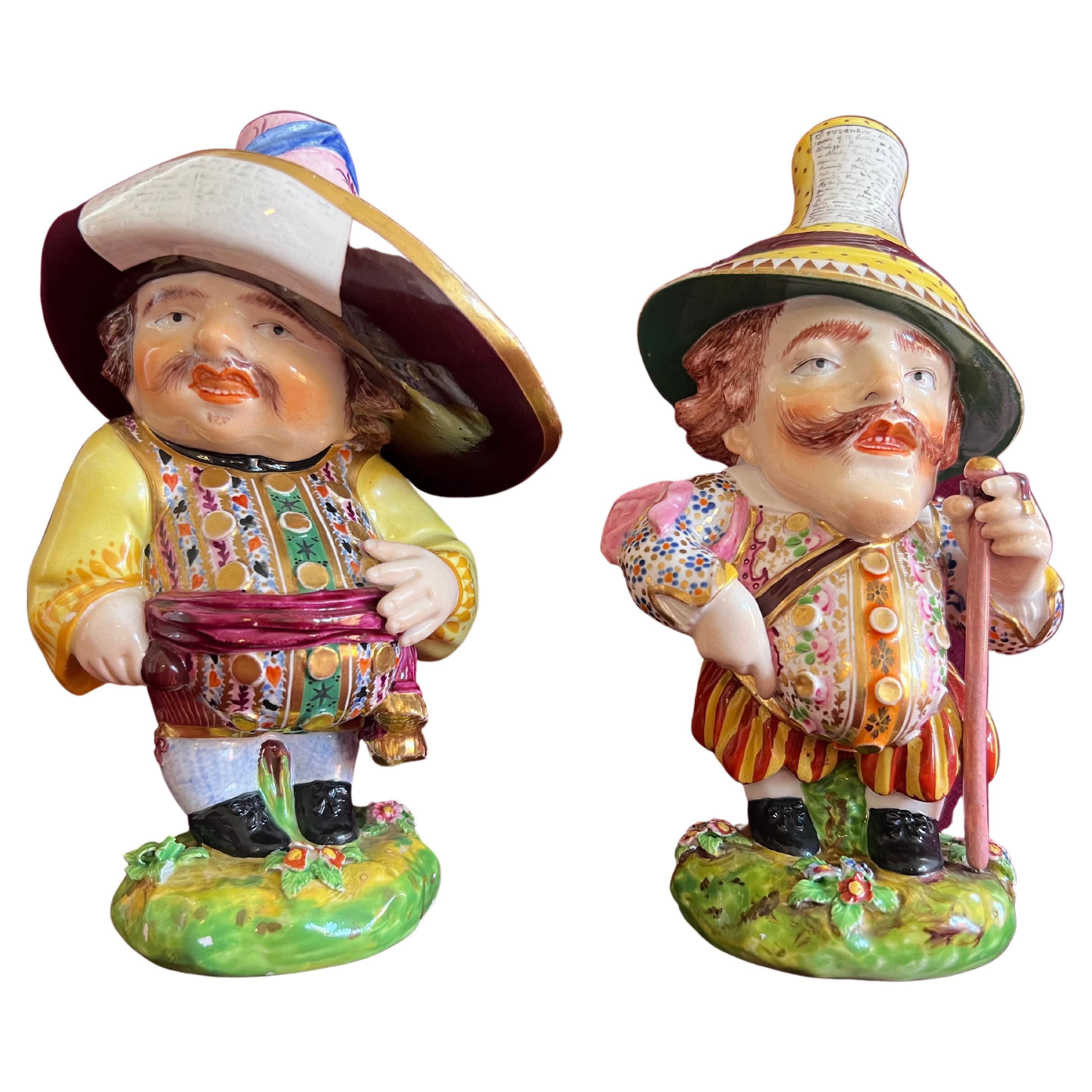Items Similar to Bloor Derby Set of 10 Plates, Fruit Paintings by Thomas Steel, Regency 1820-1825
Want more images or videos?
Request additional images or videos from the seller
1 of 21
Bloor Derby Set of 10 Plates, Fruit Paintings by Thomas Steel, Regency 1820-1825
About the Item
This is a spectacular and very rare set of ten dessert plates made by Derby in about 1825, which was the Regency era. The plates are richly gilded, each with an individual gilt pattern, and have superb fruit paintings, also each unique, by the famous porcelain decorator Thomas Steel.
One can occasionally find one of these plates in the market, but to find a whole set of 10 in such fabulous condition is extremely rare.
The Derby factory, later reshaped into Royal Crown Derby, is currently the oldest British porcelain factory still in production. Derby was one of the most prominent potteries right from the start of English porcelain production in the mid 1700s to today. Their items are of exceptionally high quality and many of the designs have become iconic, particularly the Imari designs; many of these are still being made today. Derby made many exciting designs in the Regency era, and these plates are beautiful examples. The marking at the bottom indicates that the plates were produced some time between 1806 and 1825, when the company was called "Bloor Derby"; however the style is from between 1820 and 1825.
Thomas Steel (sometimes written as Steele) is considered the very best 19th Century porcelain painter of fruits. He was born in Staffordshire in 1772 and was first apprenticed by Wedgwood. He moved to Derby in 1815, where he became the foremost flower and fruit painter. In 1825 he moved on to the Rockingham factory in Yorkshire, and a few years later to Minton in Staffordshire, where he worked the rest of his life.
Steel had a very recognisable style of fruit painting, perhaps best described by the biographer John Haslem:
"Steele painted both flowers and insects well, but as a painter of fruit on china he had no superior, if, indeed, he had any equal in his day... His grouping is harmonious, the light and shade well managed, each piece of fruit is well rounded, and the outline softened and blended into the one next to it, each partaking of the reflected colour from the other."
These plates each have a different richly gilded border, and octagonal paintings in the centre with an overflowing basket of fruits placed on a shelf. There are grapes, peaches, plums, apples, strawberries and just about any other fruit that one can find in Britain. The colours are rich and fresh and have the typical delicate colouring of Steel with sage green and deep purple accents.
The plates are marked with the printed and crowned round red Bloor Derby mark that was used between 1820 and 1840, and labels from the Twinight Collection.
Provenance: Twinight Collection
Condition report The plates are in excellent condition without any noteworthy damage and no repairs. As is usual for plates from this period, all plates are crazed. There is some stacking wear around the centre of most plates, as visible in the pictures. Two plates have very fine lines coming off the rim (hardly visible, and only visible from the underside) and one plate has two minute nicks off the rim, which are hardly noticeable. The images are all in fantastic condition with only a few very small scratches here and there, as can be expected from items this old.
Antique British porcelain is never perfect. Kilns were fired on coal in the 1800s, and this meant that china from that period can have some firing specks from flying particles. British makers were also known for their experimentation, and sometimes this resulted in technically imperfect results. Due to the shrinkage in the kiln, items can have small firing lines or develop crazing over time, which should not be seen as damage but as an imperfection of the maker's recipes, probably unknown at the time of making. Items have often been used for many years and can have normal signs of wear, and gilt can have signs of slight disintegration even if never handled. I will reflect any damage, repairs, obvious stress marks, crazing or heavy wear in the item description but some minor scratches, nicks, stains and gilt disintegration can be normal for vintage items and need to be taken into account.
There is widespread confusion on the internet about the difference between chips and nicks, or hairlines and cracks. I will reflect any damage as truthfully as I can, i.e. a nick is a tiny bit of damage smaller than 1mm and a chip is something you can easily see with the eye; a glazing line is a break in the glazing only; hairline is extremely tight and/or superficial and not picked up by the finger; and a crack is obvious both to the eye and the finger. Etcetera - I try to be as accurate as I can and please feel free to ask questions or request more detailed pictures!
Dimensions 23.3cm (9.25").
- Creator:Bloor Derby (Maker),Thomas Steel (Artist)
- Dimensions:Height: 0.75 in (1.91 cm)Diameter: 9.25 in (23.5 cm)
- Sold As:Set of 10
- Style:Regency (Of the Period)
- Materials and Techniques:
- Place of Origin:
- Period:
- Date of Manufacture:1820-1825
- Condition:Wear consistent with age and use. Excellent condition; some crazing and light stacking wear, two insignificant hairlines.
- Seller Location:London, GB
- Reference Number:
About the Seller
5.0
Platinum Seller
These expertly vetted sellers are 1stDibs' most experienced sellers and are rated highest by our customers.
Established in 2016
1stDibs seller since 2019
208 sales on 1stDibs
Typical response time: <1 hour
- ShippingRetrieving quote...Ships From: London, United Kingdom
- Return PolicyA return for this item may be initiated within 14 days of delivery.
More From This SellerView All
- Bloor Derby Shell Dish, White, Floral Sprigs Moses Webster, Regency, 1820-1825By Bloor DerbyLocated in London, GBThis is a beautiful one-handled dessert serving dish or "shell" dish made by Derby between about 1820 and 1825 in the Regency era and decorated by Moses Webster. These dishes were to...Category
Antique 1820s English Regency Serving Bowls
MaterialsPorcelain
- Bloor Derby Porcelain Breakfast Cup with Plate, Gilt with Purple Flowers, Ca1825By Derby, Bloor DerbyLocated in London, GBThis is a very charming "breakfast" teacup and saucer with a plate, made by Derby / Bloor Derby between 1806 and 1825. It is likely that the set was potted between 1806 and 1825, then decorated and brought to the market around 1825. A breakfast cup is a large teacup...Category
Antique 1820s English Regency Porcelain
MaterialsPorcelain
- H&R Daniel Plate, White, Floral, Etruscan Shape, Regency, circa 1825By H&R DanielLocated in London, GBThis is a rare and beautiful cake plate made by H&R Daniel in about 1825. The plate is potted in the square "Etruscan" shape and is decorated in a white ground with a beautiful floral pattern and gilt anthemion sprigs. The plate formed part of a large tea service; we also have a trio The H & R Daniel porcelain factory was founded by Henry Daniel, son of a family of master colour makers. He headed up the decoration department in the famous Spode factory where he oversaw all the beautiful early Spode decorations. In 1822 he opened his own factory with his son Richard, creating a truly iconic body of work with the most subtle colours and beautifully painted flowers and landscapes. The Daniel factory was the last true cottage industry among the English porcelain factories, resisting the increase of industrialisation and mass production. This resulted in extraordinary and unrivalled quality, but it probably also led to the factory having to close its doors in 1846 because it could no longer compete with others who did modernise. Daniel porcelain can be hard to identify as the factory was only around for about two decades, but this short duration and the low output also means that Daniel items have become true collectors' items. The plate is unmarked except the faded pattern number 3863, which points to a date of 1825. A picture of this pattern can be seen on plate 34 of Michael Berthoud and Lybne Price's "Daniel Patterns on Porcelain". CONDITION REPORT The plate is in perfect antique condition except some very light rubbing as visible in the pictures. Antique British porcelain...Category
Antique 1820s English Regency Porcelain
MaterialsPorcelain
- Samuel Alcock Porcelain Plate, Maroon with Flowers, Regency, ca 1825By Samuel Alcock & Co.Located in London, GBThis is a very striking and rare dessert plate made by Samuel Alcock around the year 1825. The plate is square and has the "inverted shell" moulding with pierced borders, a deep maro...Category
Antique 1820s English Regency Dinner Plates
MaterialsPorcelain
- Ridgway Porcelain Plate, Green with Hand Painted Flowers, Regency ca 1825By Ridgway PorcelainLocated in London, GBThis is a very beautiful plate made by Ridgway around 1825, which is known as the Regency period. The plate has a deep green ground and hand painted flowers, and would have formed pa...Category
Antique 1820s English Regency Dinner Plates
MaterialsPorcelain
- Bloor Derby Pair of Porcelain Figures, Stag and Doe, circa 1765-1820By Derby, Bloor DerbyLocated in London, GBThis is a very charming pair of porcelain figures of a stag and a doe, probably cast by Derby in about 1760 and decorated by Bloor Derby in 1820. The figures are a simple white porce...Category
Antique 1760s English Rococo Figurative Sculptures
MaterialsPorcelain
You May Also Like
- Bloor Derby Porcelain Porter Mug in the Manner of Steel C.1820-1825By Bloor DerbyLocated in Exeter, GBA fine Bloor Derby Porcelain porter mug c.1820-1825, finely decorated in the manner of Thomas Steel with a rectangular panel of flowers in a basket on a stone ledge, with a lime gree...Category
Antique 19th Century European Porcelain
MaterialsPorcelain
- Bloor Derby Porcelain Figure of a Seated Turk C.1820By Bloor DerbyLocated in Exeter, GBA very fine Bloor Derby porcelain figure of a seated Turk, sitting cross-legged in traditional costume, a hookah at his side, on a cushion base ...Category
Antique 19th Century Porcelain
MaterialsPorcelain
- Fine Pair of Bloor Derby ‘Mansion House’ Dwarfs C.1825By Bloor DerbyLocated in Exeter, GBA fine pair of Bloor Derby ‘Mansion House’ Dwarfs c.1825. Each moustached figure modelled wearing a comically large hat bearing an advertisement, one wearing a tasselled sash about h...Category
Antique 19th Century English Porcelain
MaterialsPorcelain
- Derby Porcelain Plates, Pattern 126, Painted by William Longden, Set of SixBy DerbyLocated in Downingtown, PAThe beautiful and stylish Derby porcelain set of six plates are painted by William Longden with fruit within a heart-shaped gilt border. The fruit depicted include grapes, plums, str...Category
Antique 1790s English Georgian Dinner Plates
MaterialsPorcelain
- Set of 11 Paris Porcelain Plates, circa 1820Located in New York, NYHarlequin-border with Provincial figures in indigenous dress.Category
Antique Early 19th Century French Dinner Plates
- English Derby PlateLocated in Wilson, NCEnglish derby plate, with an over glaze crown mark and is decorated with brilliant cobalt, red, and green floral patterns. There are bold gilt highlights.Category
Antique 1820s English Porcelain
MaterialsPorcelain, Paint
Recently Viewed
View AllMore Ways To Browse
Round Plate
Older Plates
Old Plater Plates
10 Plates
Antique Plate Designs
Old Antique Plates
Small Antique Plates
Silver Plated Handles
Rare Antique Plates
England Antique Plates
Gilded Plates
Made In England Plates
Antique Style Plates
Crown Plates
English 19th Century Plates
Vintage Plate Collection
Round Plate Glass
Very Old Plate





